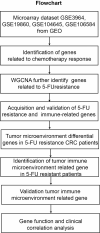Identification of Genes Related to 5-Fluorouracil Based Chemotherapy for Colorectal Cancer
- PMID: 35784334
- PMCID: PMC9247273
- DOI: 10.3389/fimmu.2022.887048
Identification of Genes Related to 5-Fluorouracil Based Chemotherapy for Colorectal Cancer
Abstract
Background: Colorectal cancer (CRC) is one of the most common malignancies and its incidence and mortality are increasing yearly. 5-Fluorouracil (5-FU) has long been used as a standard first-line treatment for CRC patients. Although 5-FU-based chemotherapy is effective for advanced CRC, the consequent resistance remains a key problem and causes the poor prognosis of CRC patients. Thus, there is an urgent need to identify new biomarkers to predict the response to 5-FU-based chemotherapy.
Methods: CRC samples were retrieved from Gene Expression Omnibus (GEO) and The Cancer Genome Atlas (TCGA). The immune-related genes were retrieved from the ImmPort database. Single-cell sequencing results from colorectal cancer were obtained by the ArrayExpress database. 5-FU resistance-related genes were filtered and validated by R packages. ESTIMATE algorithms were used to assess the tumor microenvironment (TME). KEGG and GO analysis were performed to explore the biological signaling pathway for resistant-response patients and sensitive-response patients in the tumor microenvironment. pRRophetic algorithms were used to predict 5-FU sensitivity. GSEA and GSVA analysis was performed to excavate the biological signaling pathway of the RBP7 gene.
Results: Nine immune-related genes were identified to be associated with 5-FU resistance and poor disease-free survival (DFS) of CRC patients and the signature of these genes was developed in a DFS-prognostic model. Four immune-related genes were determined to be associated with 5-FU resistance and overall survival (OS) of CRC patients. The signature of these genes was developed an OS-prognostic model. ESTIMATE scores showed a significant difference between 5-FU resistant and 5-FU sensitive CRC patients. Resistant-response patients and sensitive-response patients to 5-FU based chemotherapy showed different GO and KEGG enrichment on the tumor microenvironment. RBP7, as a tumor immune microenvironment (TIME) related gene, was found to have the potential of predicting chemotherapy resistance and poor prognosis of CRC patients. GSEA analysis showed multiple signaling differences between the high and low expression of RBP7 in CRC patients. Hypoxia and TNFα signaling via NFκB gene sets were significantly different between chemotherapy resistant (RBP7High) and chemotherapy sensitive (RBP7Low) patients. Single-cell RNA-seq suggested RBP7 was centrally distributed in endothelial stalk cells, endothelial tip cells, and myeloid cells.
Conclusions: Immune-related genes will hopefully be potential prognostic biomarkers to predict chemotherapy resistance for CRC. RBP7 may function as a tumor microenvironment regulator to induce 5-FU resistance, thereby affecting the prognosis of CRC patients.
Keywords: 5-FU resistance; colorectal cancer; immune-related genes; prognosis; tumor microenvironment.
Copyright © 2022 Huang, Ke, Jin, Zhu, Zhu, Mei, Zhang, Yu, Shou, Sun, Feng, Duan, Mou, Xie, Wu and Sui.
Conflict of interest statement
The authors declare that the research was conducted in the absence of any commercial or financial relationships that could be construed as a potential conflict of interest.
Figures









Similar articles
-
Integrated analysis reveals a novel 5-fluorouracil resistance-based prognostic signature with promising implications for predicting the efficacy of chemotherapy and immunotherapy in patients with colorectal cancer.Apoptosis. 2024 Aug;29(7-8):1126-1144. doi: 10.1007/s10495-024-01981-2. Epub 2024 Jun 2. Apoptosis. 2024. PMID: 38824480
-
Selumetinib overcomes ITGA2-induced 5-fluorouracil resistance in colorectal cancer.Int Immunopharmacol. 2024 Aug 20;137:112487. doi: 10.1016/j.intimp.2024.112487. Epub 2024 Jun 17. Int Immunopharmacol. 2024. PMID: 38889513
-
Identification of prognostic immune-related gene signature associated with tumor microenvironment of colorectal cancer.BMC Cancer. 2021 Aug 8;21(1):905. doi: 10.1186/s12885-021-08629-3. BMC Cancer. 2021. PMID: 34364366 Free PMC article.
-
Innovative Strategies to Combat 5-Fluorouracil Resistance in Colorectal Cancer: The Role of Phytochemicals and Extracellular Vesicles.Int J Mol Sci. 2024 Jul 8;25(13):7470. doi: 10.3390/ijms25137470. Int J Mol Sci. 2024. PMID: 39000577 Free PMC article. Review.
-
The role of microRNAs in 5-FU resistance of colorectal cancer: Possible mechanisms.J Cell Physiol. 2019 Mar;234(3):2306-2316. doi: 10.1002/jcp.27221. Epub 2018 Sep 7. J Cell Physiol. 2019. PMID: 30191973 Review.
Cited by
-
Mechanism of 5-fluorouracil induced resistance and role of piperine and curcumin as chemo-sensitizers in colon cancer.Naunyn Schmiedebergs Arch Pharmacol. 2024 Nov;397(11):8445-8475. doi: 10.1007/s00210-024-03189-2. Epub 2024 Jun 15. Naunyn Schmiedebergs Arch Pharmacol. 2024. PMID: 38878089 Review.
-
Sparassis latifolia and exercise training as complementary medicine mitigated the 5-fluorouracil potent side effects in mice with colorectal cancer: bioinformatics approaches, novel monitoring pathological metrics, screening signatures, and innovative management tactic.Cancer Cell Int. 2024 Apr 18;24(1):141. doi: 10.1186/s12935-024-03328-y. Cancer Cell Int. 2024. PMID: 38637796 Free PMC article.
-
Construction and validation of an anoikis-related long non-coding RNA-based prognostic model for head and neck squamous cell carcinoma.Transl Cancer Res. 2025 Jul 30;14(7):4160-4178. doi: 10.21037/tcr-2024-2520. Epub 2025 Jul 25. Transl Cancer Res. 2025. PMID: 40792140 Free PMC article.
-
Development and validation of a prognostic risk signature for lung adenocarcinoma constructed by six ferroptosis, necroptosis, and pyroptosis-related lncRNAs.J Thorac Dis. 2022 Oct;14(10):3955-3974. doi: 10.21037/jtd-22-1151. J Thorac Dis. 2022. PMID: 36389299 Free PMC article.
-
Therapeutic effects and mechanisms of plant-derived natural compounds against intestinal mucositis.Front Pharmacol. 2022 Sep 21;13:969550. doi: 10.3389/fphar.2022.969550. eCollection 2022. Front Pharmacol. 2022. PMID: 36210837 Free PMC article. Review.
References
-
- Wilkinson NW, Yothers G, Lopa S, Costantino JP, Petrelli NJ, Wolmark N. Long-Term Survival Results of Surgery Alone Versus Surgery Plus 5-Fluorouracil and Leucovorin for Stage II and Stage III Colon Cancer: Pooled Analysis of NSABP C-01 Through C-05. A Baseline From Which to Compare Modern Adjuvant Trials. Ann Surg Oncol (2010) 17:959–66. doi: 10.1245/s10434-009-0881-y - DOI - PMC - PubMed
-
- Sargent DJ, Patiyil S, Yothers G, Haller DG, Gray R, Benedetti J, et al. . End Points for Colon Cancer Adjuvant Trials: Observations and Recommendations Based on Individual Patient Data From 20,898 Patients Enrolled Onto 18 Randomized Trials From the ACCENT Group. J Clin Oncol (2007) 25:4569–74. doi: 10.1200/JCO.2006.10.4323 - DOI - PubMed
Publication types
MeSH terms
Substances
LinkOut - more resources
Full Text Sources
Medical

